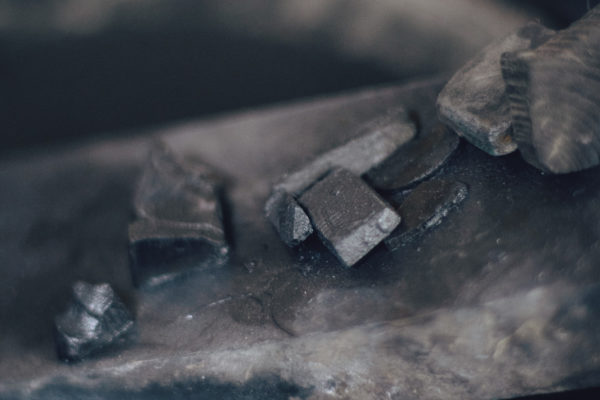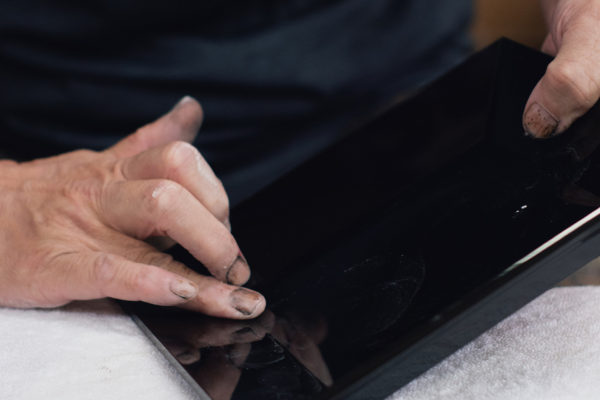ARTICLES
Roiro
Roiro is a technique incorporated to further polish the finished upper lacquer surface to give it a polished gloss like a mirror surface. Quality charcoal finishing and even fingers and sebum of the craftsmen are used as tools to complete the lacquerware without even the slightest scratches. It is the job of a Roiro-shi to conduct the above “Tsuya-age” process in addition to several Kawari-nuri techniques: Kanshitsu-nuri (a technique where you sprinkle dried lacquer powder to create multiple lacquer coating) and Nashiji-nuri (polishing lacquered surface and revealing gold/silver powder).
Process Overview

1 Roiro Polishing
Conduct wet sanding of the Roiro lacquer surface using charcoal finishing. Next, put oil-crafted polishing powder on a piece of cloth to polish the wet-sanded surface (this process is called “Dozuri”).

2 Wiping
Use a piece of wet cloth to wipe off excess oil contents and impurities from Dozuri, then wipe thoroughly using a soft piece of cloth. Store it in a special cabinet (“Furo”).

3 Suriurushi
Coat the sanded surface with high-quality raw lacquer. Next, use a piece of soft cloth to wipe it off adequately, and then store it in a Nushiburo (drying chamber).

4 Tsuya-age
Lightly rub the lacquer surface with oil-soaked cotton. Put some deer horn powder or titanium on your fingers’ balls little by little. Use also the palm of your hand to polish it in a rubbing motion. Then, repeat steps 3) and 4).

[Tools]
Charcoal finishing (Suruga charcoal), polishing powder, deer horn powder, raw lacquer, Nushiburo (drying chamber), etc.

[Features and Use of Techniques]
Sanding plays a key role in all the processes, from the first coating to the final coating. Of these, Roiro is the only sanding technique for finishing. People describe the transparent and glossy finish from this technique as having “luster like a mirror surface.” These are the amazing results of the Roiro technique, which relentlessly pursues sanding and polishing. The results are evidence that this is a technique like no other.
“What we pursue is the perfect gloss. In other words, we think about how we can make the polishing as perfect as possible. That’s where a Roiro-shi demonstrates their skills,” said Kiyoshi Ohashi, the owner of the Ohashi Roiro Store in Wajima. He always trains daily to master the polishing technique. His best tool? His hand.
“All the professionals need to use their hands. When it comes to a Roiro-shi, though, the hands are literally our tools. I use my left hand to firmly hold the lacquerware and polish it with my right hand. To make the force even, I need to relax, so my right hand tends to be relaxed. This is also the case when I’m sanding with charcoal finishing. In addition, I try to apply the same amount of force as when I’m polishing by hand as much as possible. I adjust the finishing touch by changing the number of times I do sanding and polishing. It is something that takes a lot of time and effort, but without it, the finishing touch will not be beautiful.”
“The more glossy something is, the more tiny scratches stand out.” That’s why even the finest scratches from polishing are avoided by taking care of your hands well as they are essential tools.
“Even the slightest mistake in the amount of force applied can result in a scratch. Also, you need to be careful when the humidity is dry. For example, I have dry skin, so before I start polishing, I rub my whole palm with pumice and apply Japanese sake as a moisturizer.”
As a Roiro-shi, Kiyoshi usually creates various household items. Still, he wants to expand the Roiro technique usage to arts in addition to his practical creations.
“I don’t usually try it, but there is a technique called Irozuri. Simply put, it’s a Suriurushi technique where you mix in color pigments. When you repeat this and wipe it several times, you can create a thin layer with a mist-like color texture. It’s like a somewhat colored frosted glass. However, lacquer gets thinner with time, and sometimes only the pigments remain. If I could control these changes on purpose, I may be able to create something interesting. In other words, it would be a kind of artwork with hidden patterns due to the lacquer, but as time passes, you gradually see more and more patterns underneath.”
For daily uses, eroded lacquer may be fine, but for admiration, lacquer erosion is a type of change, a depreciation of completed artwork, and is not highly regarded. Therefore, Kiyoshi has always thought these could not be considered artwork. Kiyoshi said that’s why he reached a conclusion to turn this disadvantage around and use the change as an effect on purpose. It was utilized differently so that the disadvantage would turn into an advantage. Kiyoshi’s idea that instills a new value can be inspiring for coming up with effective ideas for many technique applications, not just limited to Roiro.
